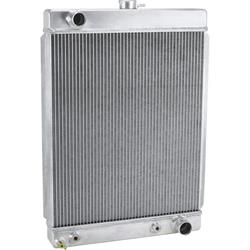Does a Fan Shroud Make a Difference?
Is a Fan Shroud Necessary?
You may think some of the things in your engine bay are pointless, like that fan shroud mounted to the engine side of your radiator. We are here to tell you: LEAVE it there! You may think that a shroud is a useless piece of plastic or metal, but they really do serve a purpose. They focus airflow through the entire radiator core as compared to just the area that is covered by the traditional fan, creating an airflow channel that pulls air through the entire surface area of the radiator core, thus increasing cooling.
An un-shrouded fan, like the one shown here, is only moving air through the portion of the radiator equal to the surface area of the fan, and that's if it is close enough to the radiator core to actually pull the air through the radiator's core and not just the air in front of the fan. See where we are going with this? If you spent the last week rebuilding your classic's engine, would you really want to fry it because you didn't think that shroud was needed? We thought not.
How Do You Determine Radiator Cooling Fan Coverage?
Let's do a little math, shall we? (Don't worry, we did it for you!)
To calculate the area that is covered by your fan, use the formula for determining the area of a circle shown below. As an example, we'll use our 17-inch diameter fan.
Area = (Pi) x (r2)
- Area = (3.14) x (8.52)
- Area = (3.14) x (72.5904)
- Area = 228.05"2
Now, for comparison, use the formula below to calculate the surface area of your radiator's core. We'll use our 27-inch tall universal radiator with a core height 22.25 inches; and a core width 18.25 inches for this example.
- Area = (Height) x (Width)
- Area = (22.25) x (18.25)
- Area = 406"2
Judging from the calculations above, you can see that without a shroud directing the airflow across the entire radiator core surface you are effectively only covering 56 percent of your radiator's core surface. That's barely half of your radiator's core is seeing airflow through it to help cool your engine! By simply adding the proper size shroud behind your radiator and confirming proper fan placement within the shroud, you'll ensure that 100 percent of the radiator's core surface area is used to cool your engine.
Any Additional Cooling System Tips?
- All shrouded fans should be on the engine side, no exceptions.
- Electric fans are preferred to mechanical belt driven fans, mainly due to the fan being driven off the engine and not only robbing you of horsepower but running at all engine speeds even when possibly not needed. Electric fans controlled by a temperature sensor only engage when needed and are easier to mount with a plastic or metal shroud.
- NEVER use the radiator as a ground. Electrolysis can result and it can corrode your radiator, creating leaks (usually at the most inopportune time!)
- A commonly held thought is that the fan blades on a belt driven mechanical fan should recess 50% into the shroud for optimum cooling. To get your fan in the correct position, use fan spacers or shims.
Updated by Mark Houlahan







